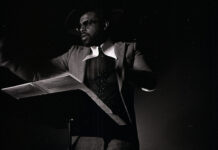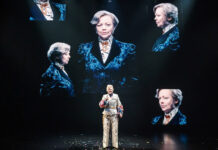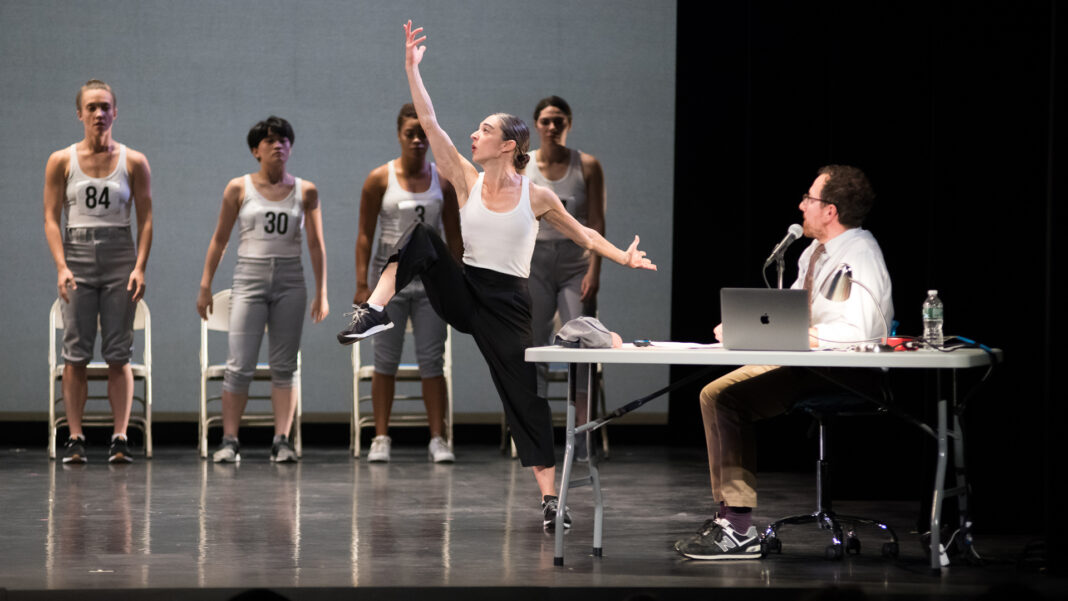Usually when you see a dance program, particularly one that tours, you can pretty much expect the same repertoire and the same company of dancers at each series of performances. That isn’t true of The Running Show from Monica Bill Barnes & Company. The show, which will be performed on Thursday, September 29th as part of USC’s Visions and Voices Series, only has a few set performers.
There’s Monica Bill Barnes, Flannery Gregg and Gerri Houlihan. The fourth person and arguably the closest collaborator with Barnes is Robbie Saenz de Viteri who serves as a play-by-play announcer offering commentary on the performance itself and on the dancers in the show.
Those dancers, in this particular performance, will be comprised of members from the USC Kaufman School of Dance. And therein lies what’s unique about The Running Show.
Barnes and de Viteri cast locals for each venue where the show is performed. Not only do they learn the choreography and work closely with Barnes over the course of a week, they also spend time talking to de Viteri who records those conversations, makes selects from what he’s learned and he incorporates those stories and sometimes the audio he’s recorded into the performance. Literally no two shows are the same.
Which gave me a lot to talk about with Barnes and de Viteri. What follows are excerpts from our conversation that have been edited for length and clarity. If you want to watch the full interview, please go to our YouTube channel.
Q: Monica, I want to start by asking you about something you told The New York Times eight years ago when you were doing an interview for Three Acts, Two Dancers, One Radio Host. You said, “I don’t feel like I’ve ever been a perfect fit in the dance world.” Have audiences caught up to what you do? Has society caught up to what you do? Because it seems like we are more welcoming of that which is unfamiliar now than we might have been eight or ten years ago.

Barnes: I got into this because I love dancing and I feel like that my identity is as a dancer. I think when you’re really immersed in an early age and that classical training, that you have a sense of the potential for beauty and grace. And that’s what I feel like I never rose to. I felt like as a human being, but also as a performer, I just didn’t feel comfortable in that esthetic in that identity. So I think in some ways it still does feel sort of true.
I also feel like I don’t see myself as the ideal dancer. I moved towards creating shows and towards collaborators like Robbie because I was interested in creating and being able to perform work that felt like it wasn’t striving towards beauty or grace or admiration; that it wanted to relate to an audience.
Something Robbie and I talk about all the time is understanding the role that the audience plays in our work; how we’re relating to them and what we’re wanting from them. There’s a real back and forth that feels very alive in our shows. I think that when you’re being admired by an audience, the relationship is a little bit more one way than I think I’m interested in.
Q: Robbie, given your your position at the, quote, unquote, press desk in the show and the sports analogies that are drawn, what Monica just said with the audience sounds similar to what fans do at a sporting event.
de Viteri: I think so much of The Running Show was really about trying to steal those narrative elements that work so well in sports. How does it change your experience of dance if you are watching movement and you’re hearing “this person was injured” or “this person started dancing when they were four years old” or “this person is 70 and they’re dancing.” If you get information about people, you get more attached to them.
I think the show goes even a step further and you really get invested in the stories of people that they share with us over the course of a week. Hearing the voices of these people and understanding their stories makes you more invested in how they move on stage.
Q: How much does fear play a part in your desire to create for both of you? Because a lot of people I talked to say, “If it doesn’t scare me, I don’t want to do it.”
Barnes: I’m looking at you, Robbie, because you have to remake the show every time we do it.

de Viteri: To create a different version of the show every time we do it is to constantly stay in the creative process. The iterative process to constantly be editing and making it is a more comfortable place to be. We got into doing this because it’s live and I think we have a very different skill set in that regard and a very different interest in that regard.
I think dance is incredibly rehearsed. You’re rehearsing today the moves that you’re going to do in a month, and you’ve already rehearsed them for years, but you’re still going to do them today.
I’m not going to read the script out loud because it’s not fully written yet, because the show will be remade for the students and for the community there in some way. I want to make sure I hold down my side of the bargain in our collaboration, which is to try to make this thing that seems incredibly rehearsed and incredibly perfected over time, seem really live and like it’s happening for the first time in that moment.
Q: How do Robbie’s choices affect how you respond to the text that’s chosen for a given show or how you want the dancers that you’ve assembled over the course of the week to respond?
Barnes: I will go in to the studio today and by myself just run the show from beginning to end. One of the things that’s really hard is not being influenced by what I’m hearing. And Robby does something that I so appreciate sort of midweek – he’ll share clips from all of the cast – most of which won’t make it into the show. Everything that strikes him that every person says and I will listen to those. I’ve been dancing with these young performers and we’ve been working together, but we don’t talk a lot in the process. I learn more in these snippets of interview that Robby shares and I really feel moved by that, by myself, in the hotel room two or three days before we get on stage.
Q: What do each of you learn from your collaborations with these with these young students and dancers?
de Viteri: Over the past couple of years a lot has happened. We did an online version of this and I asked [dancer Catherine de la Cruz], “What is it like graduating with a degree in dance when the whole field is just on pause?” And she just said “It’s like being launched into nothing.” And I feel like that phrase just burned itself in my mind.
To see people who are really in the thick of figuring out who they are at a moment when it really seems like so much of the institutions that we relied on and so much of the country in so many ways is just not there for them; it’s incredibly moving. And it makes me want to work even harder to preserve the things that really existed for me when I was 22 years old.

Barnes: We’ve been making the show for a few years now and I feel so grateful that the show brings us into contact with a 12-year old and a group of 18-19 year olds and with Gerri [77 years old]. I’ve always felt like you can understand the moment you’re having in your life better when you’re in conversation with people who are all at different moments in their lives.
Q: In her book The Life and Work of Martha Graham, the legendary dancer/choreographer wrote, “No artist is pleased. There is no satisfaction, whatever, at any time. There is only a strange divine dissatisfaction, a blessed unrest that keeps us marching, makes us more alive than the others.” How does your collaboration make each of you more alive than others?
Barnes: I think that it’s so hard to have any sense of what dance is like for anyone who hasn’t dedicated most of their life to it. I feel in so many ways there’s a perspective that Rob is bringing that I don’t that makes me see things in a way I never have. That feels so exciting and enlightening. There’s a genuine fun to the struggle of making something. There’s just a real joy that is not inherent in dance. It’s not an art form that I think you go to to have a good time. I’m so grateful for the complicated fun that it is to make something together.
de Viteri: I would call Monica the most happily dissatisfied person that I know. And I think there’s no way to say that Monica is dissatisfied without seeming like she’s miserable or something. And that’s not true at all. She’s an incredibly positive person. And I don’t see [her] ever come up to any road that seems difficult without approaching it with a sense of positivity. And you’re never satisfied with what happened along the way. And I feel that way myself. So I think there’s a real kinship to that, which is helpful.
But at the same time, I think I get the power of your dissatisfaction combined with my dissatisfaction and I feel like that’s really helpful. I think we take really big steps and really big leaps because we’re sort of going off of two people’s sense of dissatisfaction with things in a way.
To see the full interview with Monica Bill Barnes and Robbie Saenz de Viteri, please go here.
Main photo: Monica Bill Barnes & the company of The Running Show (Photo by Paula Lobo)










